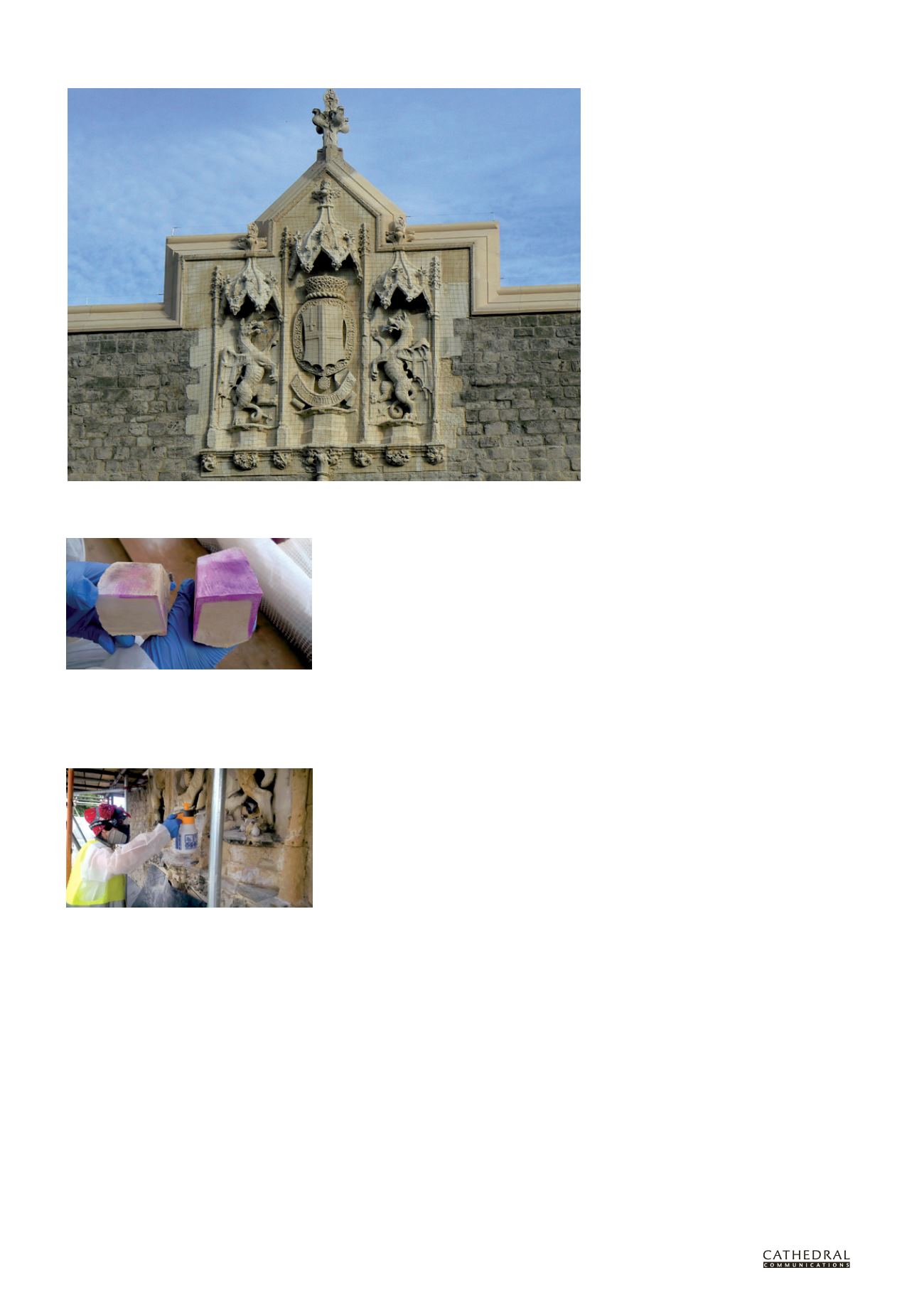

20
BCD SPECIAL REPORT ON
HISTORIC CHURCHES
24
TH ANNUAL EDITION
decay. This contained lime putty,
Prompt natural cement, Westerham
sand and Bath stone dust in the
proportions 2:1:3:3 (lime: natural
cement: sand: stone dust).
4 Stone elements which were at risk of
falling because of their overhanging
position were replaced like-for-like
in Caen stone. Two such stones were
the shield bearing the city crest and
the Muscovy hat, both of which
had multiple fractures and were at
considerable risk of detachment.
Once the repairs were completed,
the whole area was given five coats
of specially colour-blended, casein-
bound limewash to unite the central
panel. This also helped to cover any
white bloom from the nanolime
and will further protect the fragile
nature of the carved work.
Remodelling selected areas of cement
repairs in lime mortar helped to slow
down the decay of the stone and the
nanolime definitely improved the many
flaky, friable surfaces on the panel,
providing a much firmer surface for
the application of limewash. Nanolime
consolidation seems a viable method
for surface protection but for deep
penetration it proved difficult to achieve
reliably. Tests indicated that the best
penetration achieved was 7mm using
Calosil E5 (illustrated above left), which
was generally considered sufficient to bind
the friable surfaces to sound substrate.
Better results have been obtained in
laboratory conditions. The environmental
factors of temperature and particularly
relative humidity (RH) have a major effect
on the time required for evaporation of
the ethanol and consequent depth that
nanolime is carried into the stone. Colder,
overcast days with high RH offer the best
conditions for obtaining good penetration
results on site.
Used in conjunction with
mortar repairs and limewashing, the
consolidating effect to the surface
provided an excellent ground to receive
further treatments of lime protection,
given that the friable stone surfaces are
not sound enough to bond properly with
mortar and limewash.
It is tempting to view nanolime as
a new wonder treatment. In practice,
however, its success depends on many
variables, including the pore structure
of the stone and the type of damage that
has occurred, as outlined in Historic
England’s new research publication.
In some stones, for example, the pore
structure may have limited continuity,
reducing the depth of penetration,
and larger gaps and fissures cannot
be bridged by nanolime alone, such
as where delamination has occurred.
The research also highlights problems
where limestones are covered by a
gypsum crust, as this layer can be almost
completely impermeable, and any
consolidation may actually be counter-
productive. Nevertheless, what nanolime
does offer is another weapon in an
arsenal of conservation materials, and
in many situations it can be used very
effectively in combination with other
lime products.
In this case, the entrance screen
certainly benefitted from this new
material in slowing down the complex
combination of decay mechanisms which
were eroding the central panel. Nanolime
is not suited to every situation but it does
offer an option to stave off the need to
replace original fabric and extend the life
of our historic structures without always
having to resort to stone replacement or
less sympathetic consolidants.
BEN NEWMAN
is a stonemason and project
manager for London Stone Conservation (see
page 21, a member of the SPAB’s Education
and Training Committee and a William
Morris Craft Fellow. He is also a Freeman of
The Worshipful Company of Masons and a
member of its Craft Training Committee.
Further Information
P D’Armada and E Hirst, ‘Nano-Lime
for Consolidation of Plaster and Stone’,
Journal of Architectural Conservation
,
Vol 18, No 1, 2012
JL Hull, ‘Can Nano-lime Stone
Consolidation offer a Feasible
Conservation Method for Limestone
Ecclesiastical Buildings?’, University
of the West of England, Bristol, 2012
(http://bc-url.com/stone-consolidation)D Odgers et al,
Nanolime: A Practical
Guide to its Use for Consolidating
Weathered Limestone,
Historic England
2017
(http://bc-url.com/nanolime)J Otero et al, ‘An Overview of Nanolime as
a Consolidation Method for Calcareous
Substrates’, Sheffield Hallam University,
2016
(http://bc-url.com/nano-lime)
The depth of penetration of the nanolime was gauged
with the use of phenolphthalein, which turns pink in
the presence of un-carbonated lime. The sample of
stone treated with the nanolime was cut in half and
sprayed with the indicator: the depth of penetration
is clearly seen.
Nanolime was applied with a pressurised garden
spray and the area was covered in cling-film between
applications to delay evaporation of the ethanol and
promote maximum penetration.
The central crest after consolidation and repair: note the new stone shield, Muscovy hat, copings and foliate
corbels with nanolime consolidation and limewash.


















